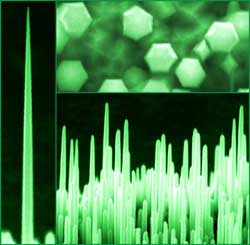Needles Capture Whispers of Light

Whispering galleries, such as the rotunda in London’s St. Paul’s Cathedral, guide sound waves between two points, so friends standing far apart can whisper conversations. In the 3 September PRL, researchers report that they have created the smallest whispering galleries–only nanometers across–although they work for light instead of sound. Each of their whispering galleries is a crystalline zinc oxide needle that tapers from 800 nanometers to a fine point. Just as an acoustic whispering gallery “selects” sound arising from a specific position, the researchers’ whispering galleries select light of a specific wavelength from among all the colors available. The authors believe their needles will help researchers understand the behavior of light at nanoscales, an important step in creating nanolasers for quantum data transfer, microscopy, and lithography.
Light enters a so-called whispering-gallery mode when it gets trapped circulating inside a material on a repeating path, glancing off the walls at shallow angles. If the length of a single circuit is an exact multiple of the wavelength, the light waves will overlap perfectly on each successive round, reinforcing each other and intensifying the light. When the light at these resonant wavelengths leaks out, it is brighter than light at other wavelengths, which tends to cancel itself out. Researchers have found whispering galleries in everything from semiconductor discs to liquid droplets.
Now a team led by Marius Grundmann of the University of Leipzig in Germany has fabricated and analyzed the smallest whispering galleries for visible light. The team grew the nano-needles by saturating droplets of molten gold with zinc oxide plasma. Zinc oxide nano-crystals then grew out of the gold into tall spires with hexagonal cross-sections.
Next the researchers trained an electron beam on a nano-needle, which excited the zinc oxide and caused it to glow green. Their detector analyzed the light emitted at each position along the needle and revealed from one to three wavelengths that were amplified above the rest. Each of these wavelengths “fit” a specific number of times–from one to six–into a single hexagonal circuit around the needle’s cross-section. The team observed the effect down to a needle diameter of about 250 nanometers.
University of Leipzig team member Thomas Nobis says the researchers were surprised to see the effects. The whispering gallery theory involves light rays bouncing off mirror-like surfaces and ought not to work when you shrink the region to a size not much larger than the light’s wavelength. In that case, Nobis says, “all the ray-optics pictures start to loose their validity. However, since we still see the [whispering gallery modes],” he says, “one can say that the simple picture isn’t totally wrong.”
Ortwin Hess of the University of Surrey in England says he has some reservations about applying theories that “have not been directly deduced for cavities of that small size.” Nonetheless, “it is quite a good experimental achievement,” he says. The experiments demonstrate, Nobis says, that it is possible to channel light in this manner in the nanoworld, which could help lead the way to new types of light-guiding nanofibers and nanolasers.
–Chelsea Wald
In 2006 Chelsea Wald was a science writing intern at APS. Now she is a freelance science writer in the Netherlands and the author of Pipe Dreams: The Urgent Global Quest to Transform the Toilet (Simon & Schuster, 2021).
More Information
whispering gallery modes and microlasers from the University of Oregon


